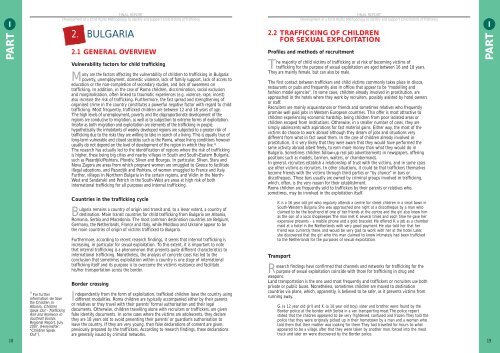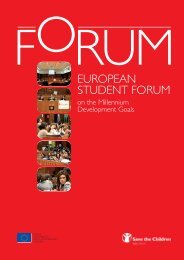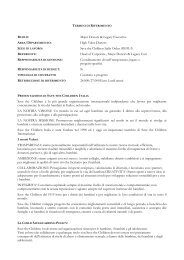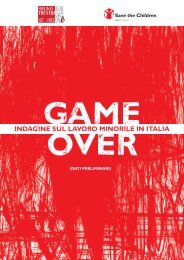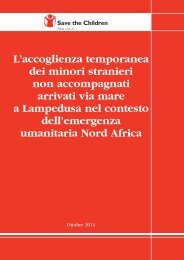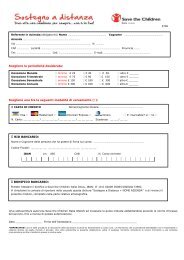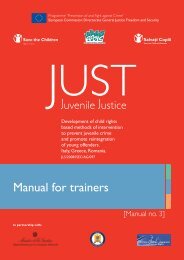FINAL REPORT - Save the Children Italia Onlus
FINAL REPORT - Save the Children Italia Onlus
FINAL REPORT - Save the Children Italia Onlus
You also want an ePaper? Increase the reach of your titles
YUMPU automatically turns print PDFs into web optimized ePapers that Google loves.
IPART1818For fur<strong>the</strong>rinformation see <strong>Save</strong><strong>the</strong> <strong>Children</strong> inAlbania, <strong>Children</strong>Speak Out - TraffickingRisk and Resilience inSou<strong>the</strong>ast Europe,Regional Report, July2007. (Hereinafter:“<strong>Children</strong> SpeakOut”).<strong>FINAL</strong> <strong>REPORT</strong>Development of a Child Rights Methodology to Identify and Support Child Victims of Trafficking2. BULGARIA2.1 GENERAL OVERVIEWVulnerability factors for child traffickingMany are <strong>the</strong> factors affecting <strong>the</strong> vulnerability of children to trafficking in Bulgaria:poverty, unemployment, domestic violence, lack of family support, lack of access toeducation or <strong>the</strong> non-completion of secondary studies, and lack of awareness ontrafficking. In addition, in <strong>the</strong> case of Roma children, discrimination, social exclusionand marginalisation, often linked to traumatic experiences (e.g. violence, rape, incest)also increase <strong>the</strong> risk of trafficking. Fur<strong>the</strong>rmore, <strong>the</strong> fast spread and streng<strong>the</strong>ning oforganised crime in <strong>the</strong> country constitutes a powerful negative factor with regard to childtrafficking. Most frequently, trafficked children are between 12 and 18 years of age.The high levels of unemployment, poverty and <strong>the</strong> disproportionate development of <strong>the</strong>regions are conducive to migration, as well as to subjection to extreme forms of exploitation.Insofar as both migration and exploitation are elements of <strong>the</strong> trafficking in people,hypo<strong>the</strong>tically <strong>the</strong> inhabitants of weakly developed regions are subjected to a greater risk oftrafficking due to <strong>the</strong> risks <strong>the</strong>y are willing to take in search of a living. This is equally true oflong-term vulnerable and closed societies such as <strong>the</strong> Roma, whose living conditions howeverusually do not depend on <strong>the</strong> level of development of <strong>the</strong> region in which <strong>the</strong>y live. 18The research has actually led to <strong>the</strong> identification of regions where <strong>the</strong> risk of traffickingis higher, <strong>the</strong>se being big cities and nearby villages in South and South-Eastern Bulgaria,such as Pazardjik/Peshtera, Plovdiv, Sliven and Bourgas. In particular, Sliven, Stara andNova Zagora are areas from which pregnant women are smuggled to Greece to facilitateillegal adoptions, and Pazardjik and Peshtera, of women smuggled to France and Italy.Fur<strong>the</strong>r, villages in Nor<strong>the</strong>rn Bulgaria in <strong>the</strong> certain regions, and Vidin in <strong>the</strong> North-West and Sandanski and Petrich in <strong>the</strong> South-West are areas at high risk of bothinternational trafficking for all purposes and internal trafficking.Countries in <strong>the</strong> trafficking cycleBulgaria remains a country of origin and transit and, to a lesser extent, a country ofdestination. Main transit countries for child trafficking from Bulgaria are Albania,Romania, Serbia and Macedonia. The most common destination countries are Belgium,Germany, <strong>the</strong> Ne<strong>the</strong>rlands, France and Italy, while Moldova and Ukraine appear to be<strong>the</strong> main countries of origin of victims trafficked to Bulgaria.Fur<strong>the</strong>rmore, according to recent research findings, it seems that internal trafficking isincreasing, in particular for sexual exploitation. To this extent, it is important to notethat internal trafficking is a phenomenon that presents quite different characteristics tointernational trafficking. None<strong>the</strong>less, <strong>the</strong> analysis of concrete cases has led to <strong>the</strong>conclusion that sometimes exploitation within a country is one stage of internationaltrafficking itself and its purpose is to overcome <strong>the</strong> victim’s resistance and facilitatehis/her transportation across <strong>the</strong> border.Border crossingIndependently from <strong>the</strong> form of exploitation, trafficked children leave <strong>the</strong> country usingdifferent modalities. Roma children are typically accompanied ei<strong>the</strong>r by <strong>the</strong>ir parentsor relatives or <strong>the</strong>y travel with <strong>the</strong>ir parents’ formal authorisation and <strong>the</strong>ir legaldocuments. O<strong>the</strong>rwise, children travelling alone with recruiters or traffickers, are givenfalse identity documents. In some cases where <strong>the</strong> victims are adolescents, <strong>the</strong>y declare<strong>the</strong>y are 18 years old to avoid presenting <strong>the</strong>ir parents’ or guardian’s authorisation toleave <strong>the</strong> country. If <strong>the</strong>y are very young, <strong>the</strong>n false declarations of consent are given,previously prepared by <strong>the</strong> traffickers. According to research findings, <strong>the</strong>se declarationsare generally issued by criminal networks.<strong>FINAL</strong> <strong>REPORT</strong>Development of a Child Rights Methodology to Identify and Support Child Victims of Trafficking2.2 TRAFFICKING OF CHILDRENFOR SEXUAL EXPLOITATIONProfiles and methods of recruitmentThe majority of child victims of trafficking or at risk of becoming victims oftrafficking for <strong>the</strong> purpose of sexual exploitation are aged between 16 and 18 years.They are mainly female, but can also be male.The first contact between traffickers and child victims commonly takes place in discos,restaurants or pubs and frequently also in offices that appear to be “modelling andfashion model agencies”. In some cases, children already involved in prostitution, areapproached in <strong>the</strong> hotels where <strong>the</strong>y work by recruiters, possibly assisted by hotel ownersor staff.Recruiters are mainly acquaintances or friends and sometimes relatives who frequentlypromise well paid jobs in Western European countries. This offer is most attractive tochildren experiencing economic hardship, being children from poor isolated areas orchildren escaped from institutions. O<strong>the</strong>rwise, in a smaller number of cases, <strong>the</strong>y aresimply adolescents with aspirations for fast material gains. Ei<strong>the</strong>r way, <strong>the</strong> most of <strong>the</strong>victims do choose to work abroad although <strong>the</strong>y dream of jobs and situations verydifferent from what in fact await <strong>the</strong>m. In <strong>the</strong> case of children already involved inprostitution, it is very likely that <strong>the</strong>y were aware that <strong>the</strong>y would have performed <strong>the</strong>same activity abroad albeit freely, to earn more money than what <strong>the</strong>y would do inBulgaria. Sometimes children follow-up real job advertisements in newspapers, offeringpositions such as models, barmen, waiters, or chambermaids.In general, recruiters establish a relationship of trust with <strong>the</strong> victims, and in some casesuse o<strong>the</strong>r victims as recruiters. In o<strong>the</strong>r situations, it could be that traffickers <strong>the</strong>mselvesbecome friends with <strong>the</strong> victims through third parties or “by chance” in bars ordisco<strong>the</strong>ques. These bars usually are owned by criminal groups involved in trafficking,which, often, is <strong>the</strong> very reason for <strong>the</strong>ir establishment.Roma children are frequently sold to traffickers by <strong>the</strong>ir parents or relatives who,sometimes, may be involved in <strong>the</strong> exploitation itself.K. is a 16 year old girl who regularly attends a centre for street children in a small town inSouth-Western Bulgaria. She was approached one night at a disco<strong>the</strong>que by a man whoclaimed to be <strong>the</strong> boyfriend of one of her friends at <strong>the</strong> centre and <strong>the</strong> girl also knew himas <strong>the</strong> son of a local shopkeeper.The man met K. several times and each time he gave herexpensive presents - a mobile phone and a gold bracelet. He offered K. a job as a chambermaid at a hotel in <strong>the</strong> Ne<strong>the</strong>rlands with very good payment. He also told her that herfriend was currently <strong>the</strong>re, and would be very glad to work with her at <strong>the</strong> hotel. Later,she discovered that <strong>the</strong> girl who this man claimed to know intimately had been traffickedto <strong>the</strong> Ne<strong>the</strong>rlands for <strong>the</strong> purposes of sexual exploitation.TransportResearch findings have confirmed that channels and networks for trafficking for <strong>the</strong>purpose of sexual exploitation coincide with those for trafficking in drug andweapons.Land transportation is <strong>the</strong> one used most frequently and traffickers or recruiters use bothprivate or public buses. None<strong>the</strong>less, sometimes children are moved to destinationcountries via plane, which, apparently, is believed to be safer, as it prevents victims fromrunning away.G. (a 12 year old girl) and K. (a 10 year old boy), sister and bro<strong>the</strong>r, were found by <strong>the</strong>Border police at <strong>the</strong> border with Serbia in a van transporting meat.The police reportstated that <strong>the</strong> children appeared to be very frightened, confused and frozen.They told <strong>the</strong>police that <strong>the</strong>y were originally picked up in <strong>the</strong>ir hometown by a man and a woman whotold <strong>the</strong>m that <strong>the</strong>ir mo<strong>the</strong>r was looking for <strong>the</strong>m.They had travelled for hours to whatappeared to be a village, after that <strong>the</strong>y were taken by ano<strong>the</strong>r man, forced into <strong>the</strong> meattruck and later on were discovered by <strong>the</strong> Border police.IPART19


